
|
- In order to store
the relationship
Works-For, we must
store tuples of this
format:
(EmployeeSSN, DNumber) (They are primary keys of each entity)
- Recall:
the properties of the Works-For
relationship:
- Employee:Department = N:1
- Employee participation = Total, Department participation = partial.
- Solution 1:
We expand
the Department relation.
- Tables of
the Entities:
Employee ( SSN, FName, MI, LName, Sex, Address, BDate, Salary ) Department ( DName, DNumber ) <---- extend THIS relation
- Notice that the
relationship
Works-For tuples are:
(DNumber, SSN)The relation (table) Department already has the DNumber attribute:
Department ( DName, DNumber )
- To represent the
relationship Works-For
by
extending
Department:
- we just have to add the SSN attribute to the relation Department
Result:
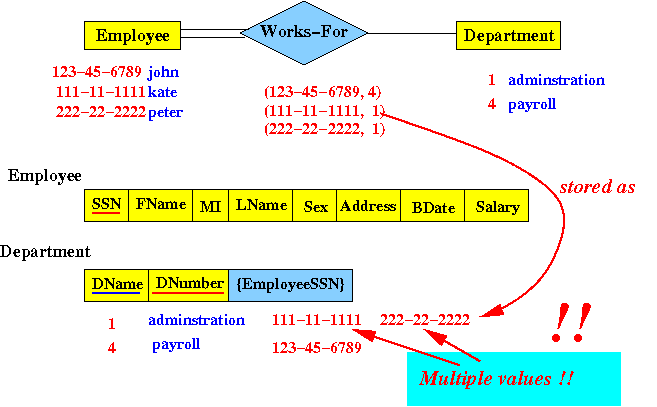
Notice that:
- EmployeeSSN is
multi-valued !!!!
(Because 1 department can have multiple employees)
- Not acceptable - violates the relational database atomic domain principle...
- Tables of
the Entities:
- Solution 2:
Expand the Employee relation.
-
Notice that the relationship tuples is of the format
(DNumber, SSN)
Again, the relation Employee already has the SSN attribute....
So we just have to add the DNumber attribute from the department to Employee....
Result:
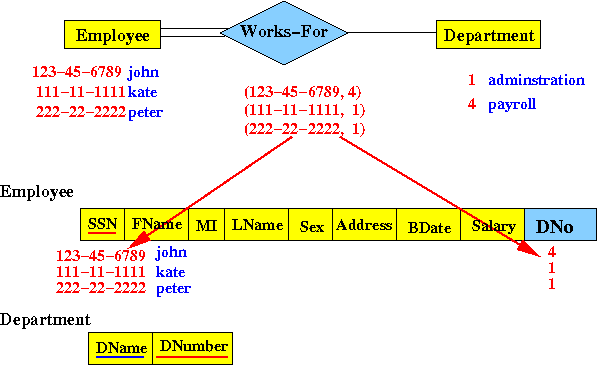
This expansion will work, because DNo is single-valued !!!
-
Sample tuples to show you that we
successfully represented
the Works-for
relationship:
SSN FName MI LName ... DNo --------------------------------------------------- 123-45-6789 John X Smith 4 111-11-1111 Kate Y Smith 1 222-22-2222 Peter Z Pan 1We can see from the tuples stored that:
- Employee 123-45-6789 works in department 4
- Employee 111-11-1111 works in department 1
- Employee 222-22-2222 works in department 1
To represent a relationship
Entity1:Entity2 = 1:N
expand the relation that represents
Entity2
|
- Controls-Project:
Department:Project = 1:N
by adding (DNum) to the Project relation
- Supervisor:
Employee(supervisor):Employee(supervisee) = 1:N
by adding (SupervisorSSN) to the Employee relation - this SSN plays the role of the supervisor
(NOTE: if you add (SuperviseeSSN) - an SSN number that plays the role of the supervisee, then this attribute is multivalued....)
- Properties of the
Manager
relationship:
- Employee:Department = 1:1
- Employee participation = Partial, Department participation = Total.
- Solution 1:
-
Expand the Employee relation with the attribute
"ManagedDNum" representing the managed department
Since the relationship is Employee:Department = 1:1, "ManagedDNum" will have atomic attribute values.
- Solution 2:
-
Expand the Department relation with the attribute
"MgrSSN" representing the SSN of the manager of the department
Again, the relationship is Employee:Department = 1:1, so "MgrSSN" will also have atomic attribute values.
- $6,000,000 Question: is there any advantage of one solution
over the other ???
Yes, definitely. Look at the participation constraints:
- Employee participation = Partial
- Department participation = Total
- Solution 1:
Employee(SSN, FName, MI, LName, ...., ManagedDNum)
The attribute ManagedDNum will contain NULL values because the participation of Employee is partial, i.e., no every employee will have a department to manage.... - employees that do not manage departments will have ManagedDNum = NULL
- Solution 2:
Department(DName, DNumber, ...., ManagerSSN)
The attribute ManagerSSN will NEVER contain NULL values because the participation of Department is TOTAL, i.e., every department will have a manager !!!
- Design rule:
- Avoid having attribute that can take on NULL values
NULL values can be a headach in formulation of some queries.
- Recall that:
- A relationship can
have attributes
Example: StartDate in the Manage relationship

- A relationship can
have attributes
- Attributes of
a relationship:
- We must put the attributes of a relationship in the same relation that we used to store the entity
- Result:
Department(DName, DNumber, ...., ManagerSSN, StartDate )Sample tuples to show you that we successfully represented the Manage relationship:
DName DNumber .... ManagerSSN StartDate ------------------------------------------------------------------------- Payroll 4 123-45-6789 1/1/2000 Adm. 1 111-11-1111 3/1/2010Can you tell which employee is the manager of the Payroll department ?
- Employee (whose SSN is) 123-45-6789
Can you tell when this employee started managing the Payroll department ?
- 1/1/2000
- Properties of the Works-On relationship:
- Employee:Project = M:N
- Employee participation = Partial, Project participation = Partial.
- Solution 1:
Expand the Employee relation with the attribute
"WorkedOnProjects" representing the projects that the employee
works on.
Since the relationship is Employee:Project = M:N, "WorkedOnProjects" will be multi-valued.
- Solution 2:
Expand the Project relation with the attribute
"WorkerSSN" representing the SSN of the employees who
work on the project.
Again, the relationship is Employee:Project = M:N, so "WorkerSSN" will also be multi-valued....
- So the "Expand an existing relation" does not work....
- Fear not, recall (see above) there is another way: create a new
relation:

- NOTE: Works-On relationship has an attribute "Hours" - this attribute must also be include into the relation
When you put everything together (as I have shown in class), you will get the following relational model:
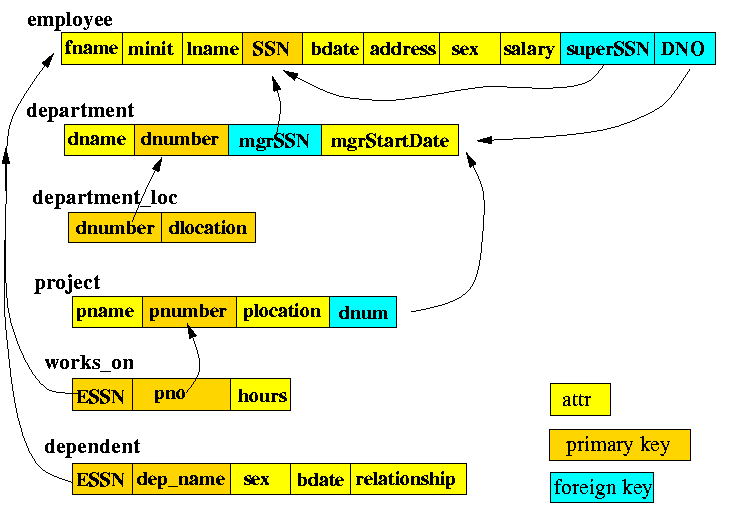
|
- Sample content on
the relations in the
Company Data Base model
(from the text book):
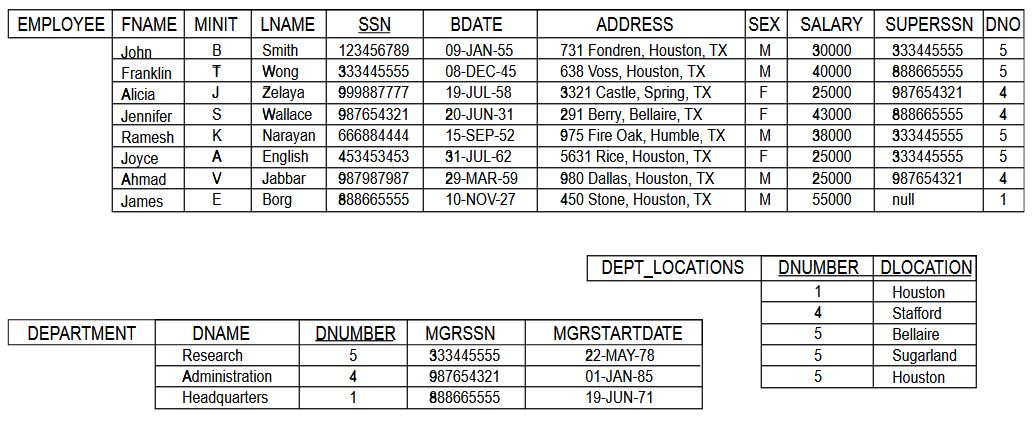
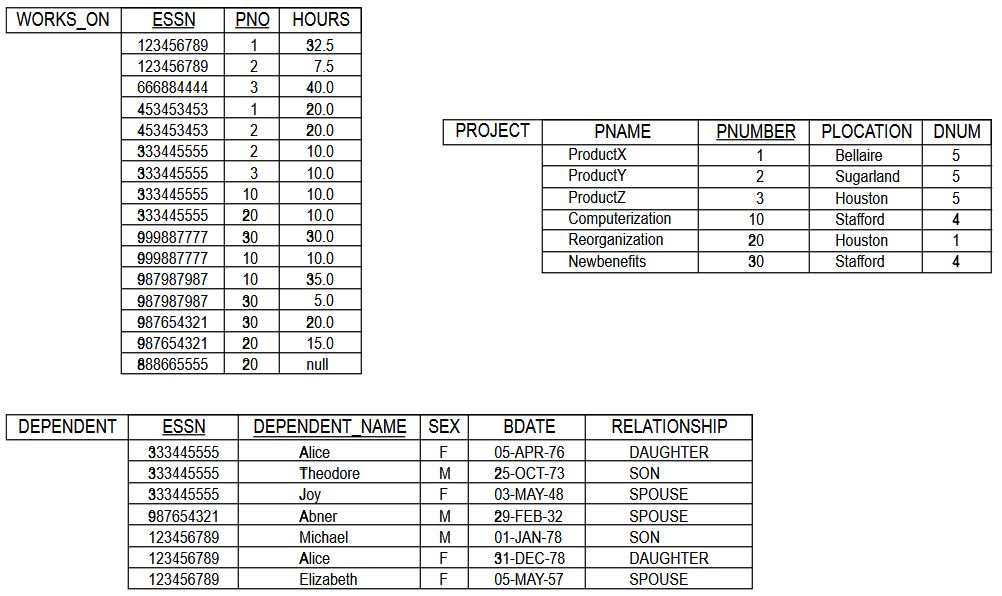
- Here is an copy of the page from the textbook:
click here
- Can you
figure out the
following information:
- Which department does John Smith work for ?
- Who are the dependents of John Smith ?
- What projects does John Smith work on (and for how many hours each week) ?
- Where is the Headquaters of the company ?
- Who manages Headquaters of the company ?